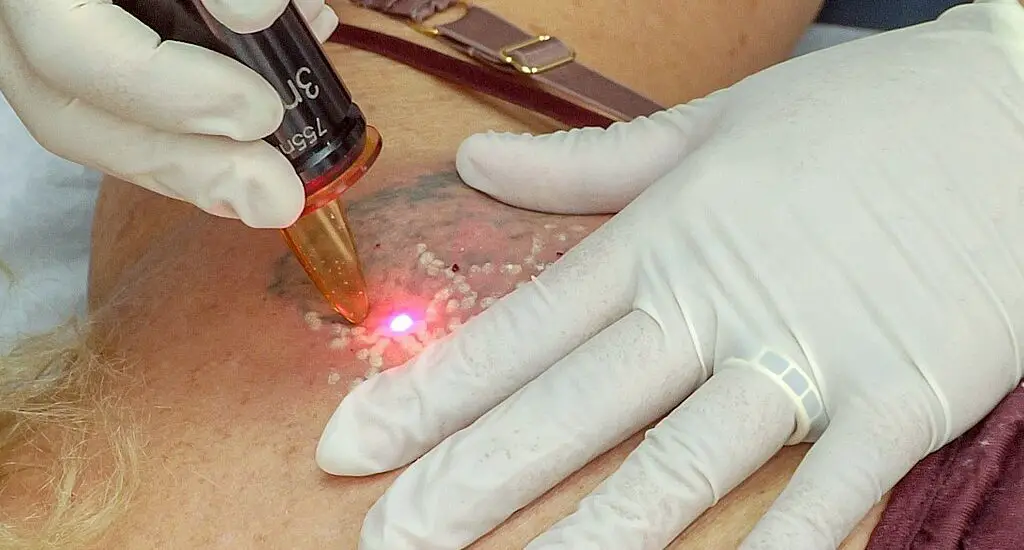How does skin look after laser tattoo removal? This guide will take you through each stage of the process, ensuring that even if you’re new to this, you’ll have a comprehensive understanding of what to expect and how to care for your skin.

Table of Contents
How Does Skin Look After Laser Tattoo Removal
We’ll answer the question “how does skin look after laser tattoo removal?” by reviewing different time durations post the procedure.
The Immediate Aftermath
Right after a laser tattoo removal session, the treated skin often looks red and may feel tender to the touch. This is a normal reaction to the laser’s intense energy, which works to break down the tattoo ink.
The white frosting that you see immediately after is caused by the release of carbon dioxide as the laser targets the ink particles, creating a small, controlled injury in the skin that looks white and frosty. This is a normal reaction and indicates that the laser is effectively breaking down the ink.
First Few Days
Following the treatment, your skin will continue to respond. You can expect some swelling and redness, akin to what you might see with a minor burn. This is your body’s natural response to the laser treatment and a sign of the beginning of the healing process.
Within the first 72 hours, blisters can form. Though possibly uncomfortable, they are a normal part of the healing process. These blisters are filled with ink and tissue fluid, and as tempting as it may be, they should not be punctured, as this can increase the risk of infection and scarring. Instead, allow them to resolve on their own.
To support healing and avoid complications, follow all aftercare instructions given by your provider diligently.
Weeks Following Treatment
In the weeks that follow, you’ll notice that the blisters have subsided, possibly leaving behind scabs or peeling skin. This is a pivotal moment in the healing process; the skin is repairing itself, and it’s crucial to let it do so undisturbed. Picking at scabs can lead to scars, potentially altering the texture and appearance of your skin permanently.
Your tattoo may appear lighter, a sign that your body is flushing away the ink particles. It’s important to keep the area clean, dry, and protected from the sun. Patience and proper aftercare are essential for your skin to recover properly and for the best results to be achieved.
A study on laser tattoo removal published in the National Institutes of Health library underscores the importance of aftercare for successful tattoo removal.
Long-Term Appearance
Months after beginning your laser tattoo removal treatments, you’ll see a progressive lightening of the tattoo. Depending on a variety of factors—like the tattoo’s age, colors, depth of the ink, and your skin type—the time it takes to completely remove a tattoo can vary widely.
After several sessions, you may notice that the treated skin looks different from the surrounding areas; this could be due to texture changes or pigmentation differences. Sometimes, hypopigmentation (lightening of the skin) or hyperpigmentation (darkening of the skin) can occur, although these conditions are often temporary.
Check out these other articles…
How to Care for Skin After Laser Tattoo Removal: Easy Guide
Skin Texture Change After Laser Tattoo Removal: Quick Guide
How to Treat a Tattoo After Laser Removal: Complete Guide
Does Tattoo Continue to Fade After Laser Treatment? Answered
Can You Get a Tattoo After Laser Removal? Detailed Answer
Factors Affecting Healing
Healing times and results can vary greatly from person to person. Your immune system plays a significant role in how quickly your body can remove the ink particles after they’ve been broken down by the laser.
The type of laser and the wavelengths used also affect how the ink responds to the treatment and consequently, how the skin heals. Following your practitioner’s aftercare instructions, which typically include keeping the area clean, avoiding sun exposure, and applying recommended ointments, is critical.
Proper aftercare ensures that you give your skin the best chance to heal effectively, reducing the likelihood of adverse effects and improving the results of your laser treatment.

